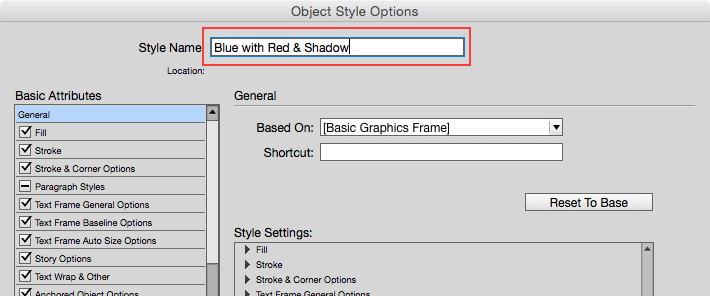

An object style can be set with the position information so that anchored objects can be positioned consistently and quickly. If you use custom anchored objects throughout a document, object styles are essential. More after the jump! Continue reading below↓įree and Premium members see fewer ads! Sign up and log-in today. TIP: If you need the lines to show up more clearly on dark backgrounds, add a small outer glow. If you’re going to use ovals or rectangles, be sure the fill is set to none. Set the stroke size and color, along with any endpoints, such as arrows, that you want to include. If you use lines, ovals or rectangles to mark callouts in graphics, use object styles to format them. No document should be without them! Using Object Styles: Callout Lines This article will help put object styles on your radar screen. Just as paragraph and character styles help you quickly format text, object styles help you quickly format various attributes of InDesign objects, including graphic frames, text frames and lines. But many of us forget about a potentially even more powerful and important tool: object styles. Most InDesign power-users know how important it is to create and apply paragraph and character styles within a document.

Let’s start with a section from Diane Burns‘ session on “Need to Know: Object Styles” from the 2014 InDesign Conference. We want to share some of our favorite excerpts with you. In addition to attendees enjoying live presentations from top InDesign experts worldwide, they get a set of detailed speakers notes from every session written just for the conference. You may love the lights or the waves, but your boss might not.The annual InDesign Conference, produced by the team, is an amazing show. Still not exciting enough? How about if you try out the Easter Egg rules we added in Adobe InDesign: Creating New Stroke Styles?Ī final thought.It gets better when you pick a more interesting underline like Wavy. Turn on the Preview button and then play with the Weight, Offset and Text Color options.Look at that! A dialog box opens up, with underline controls: Start by reselecting one of the underlined words, and then hold the Alt/Opt key on the keyboard as you click on the Underline button again in the Control panel. It’s not very attractive is it? It’s pretty darn easy to customize the underlines though, so that they transition from boring to fun.Select a couple of random words, and apply underlining by clicking on the Underline button on the Control Panel.


Ok, so why, you must be wondering, is this the first of two blog posts devoted to underlining in InDesign? The answer is that because custom underlines can do some pretty cool things that go way beyond solid black lines that underscore text. In a nutshell, you really don’t want to use underlines in your printed documentation as a form of emphasis. In professionally typeset documents, you are very unlikely to see underlines used for emphasis instead you might see italics, a weight change, a color change or some combination of the above. Originally a proofreader’s mark for italics, underlines took on a life of their own during the typewriter years, when they were one of the only ways one could emphasize text. Underlines are one of things that can identify you as new to design and layout. Posted on: February 5th, 2010 Author: barb.binder Category: Adobe InDesign by Barb Binder, Adobe Certified Instructor on InDesign Home / Adobe InDesign / Adobe InDesign: Custom Underlines Adobe InDesign: Custom Underlines


 0 kommentar(er)
0 kommentar(er)
